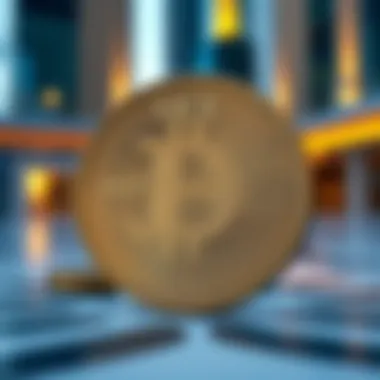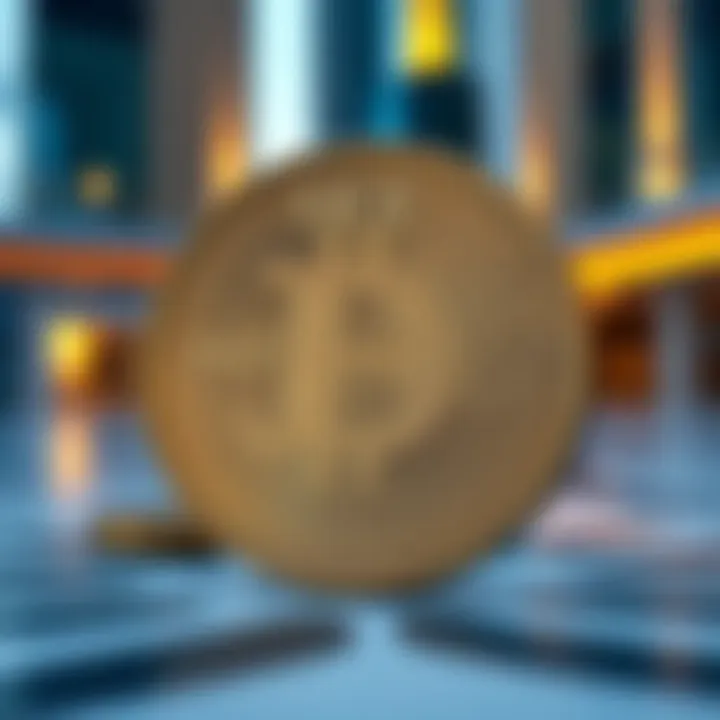Understanding AED: The Emirati Dirham's Impact on Real Estate


Intro
The Emirati Dirham (AED) stands as a significant currency in the Middle East, but it’s not merely a piece of paper or a digital number; it represents a bustling economy and a gateway to numerous investment opportunities. Understanding the AED involves diving deeper than just its exchange rate; it requires an exploration of its history, the forces that affect its value, and the broader economic ecosystem in which it operates. For investors, real estate agents, and home buyers aiming to tap into Dubai's vibrant property market, grasping how the AED intertwines with economic factors is crucial. Let us embark on this journey to explore the essence of the Emirati Dirham and its implications for the real estate landscape in Dubai.
Market Overview
Current Trends
The landscape of the AED is shaped by various elements including global oil prices, tourism rates, and economic diversification efforts by the UAE. Recently, the Dirham has showcased stability, largely due to a sound monetary policy in the region. With Dubai becoming a favorite destination for expatriates and tourists alike, the demand for AED remains steady. Investors are keeping a close eye on fluctuations in the currency, especially with international events that can impact economic indicators.
Forecast and Predictions
Looking ahead, experts suggest that the AED is likely to maintain its peg against the US dollar. As the UAE continues to bolster its reputation through ventures like Expo 2020 and the flourishing tourism sector, the Dirham's resilience appears promising. However, external factors such as geopolitical tensions and global market volatility can never be disregarded. Keeping abreast of these developments will help stakeholders better navigate their investment strategies.
"Understanding currency is not just about numbers; it's about the story behind those numbers and the implications for investment."
Investment Opportunities
Residential Properties
The real estate sector in Dubai, fueled by a growing population and an influx of foreigners, shows potent potential for residential investments. Properties in neighborhoods like Dubai Marina and Downtown Dubai are consistently in demand, making them appealing options for those looking to invest in residential structures. The AED plays a crucial role here, as property prices are often quoted in Dirhams, impacting the affordability and purchase approaches for many buyers.
Long-term rental yields can be lucrative, especially when the exchange rate remains favorable for international investors.
Commercial Ventures
Investors looking to enter the UAE market may find commercial properties particularly enticing. Areas such as Business Bay and Sheikh Zayed Road are hotspots for commercial activities. Retail spaces and office buildings in these areas tend to have high occupancy rates, translating into steady rental income. Moreover, as the economy diversifies, sectors like technology and finance are expanding, further enhancing the attractiveness of commercial investments.
The Dirham’s stability against major currencies can also provide a secure platform for foreign entities aiming to establish a presence in Dubai, helping mitigate exchange rate risks.
Prelude to AED
The Emirati Dirham, commonly referred to as AED, occupies a pivotal role in the economy of the United Arab Emirates. Understanding the AED goes beyond recognizing it as a mere unit of exchange; it reflects the historical, cultural, and economic narrative of a rapidly evolving nation. The significance of AED is vast, impacting not only local investors and consumers but also foreign entities who seek to engage in the UAE's lucrative markets.
Definition and Origin of AED
The Emirati Dirham is the official currency of the United Arab Emirates, and its issuance is managed by the Central Bank of the UAE. The name 'dirham' originates from the Greek word 'drachma', which was used in ancient times as a form of currency.
Introduced in 1973, following the unification of seven emirates, AED replaced the Qatar and Dubai riyal at a fixed rate. Historically, the Dirham has undergone several transformations, asserting its importance during different periods in the UAE's economic development.
Unique Points of AED
- The AED was pegged to the US dollar in 1980, establishing stability in exchange rates, which is crucial for international trade.
- The currency is printed in notes of various denominations and coins, contributing to its usability in everyday transactions.
This foundation not only provides insight into the currency's function but also into how it symbolizes the unification and progress of the Emirates. Understanding these origins sets the stage for comprehending the present-day implications of the Emirati Dirham within the global market.
Historical Context
To appreciate the current landscape of AED, one must consider its historical backdrop. The journey of the dirham is intricately tied to the UAE’s socio-economic evolution. In the early stages, before the formation of the UAE, various currencies such as the Indian rupee and Gulf rupee circulated, demonstrating the region's dependence on trade.
The establishment of the dirham signified a move towards economic independence, aligning with the broader vision of the emirates. Over time, AED’s stability has been reinforced by substantial oil revenues, which bolstered the country’s financial credibility on the world stage.


The robustness of the Emirati Dirham mirrors the resilience and ambition of the UAE, showcasing how a currency can be a beacon of economic stability.
Furthermore, AED has flourished amidst global financial trends, adapting to changes in the economy while maintaining its attractiveness for investors. The dirham's journey is a testament to the strategic decisions made by the UAE’s leadership, influencing investment flows and diplomatic ties.
As we navigate through the rest of this article, it becomes evident that the AED is not merely a currency but a vital component of the UAE's economic framework, shaping investment strategies and the overall market climate.
The Role of AED in the UAE Economy
The significance of the Emirati Dirham (AED) in the United Arab Emirates (UAE) economy extends far beyond mere transactions. As a currency, it weaves itself into the fabric of the nation’s economic identity, influencing business practices, investment opportunities, and market dynamics. The AED is not only a medium of exchange but also a barometer of the UAE's economic health.
One might say that the AED is the heart beating at the center of the UAE's vibrant economy, pumping life into its various sectors. Investors and buyers frequently seek guidance on the implications of AED’s performance, especially against other global currencies. To grasp the full scope of the AED's role in the UAE economy, one must consider how it interacts with economic indicators and the factors contributing to inflation and pricing.
Economic Indicators Linked to AED
Several economic indicators are closely knitted with the performance of the AED. Understanding these indicators is crucial for anyone interested in the UAE's economy. Here are some pertinent indicators:
- Gross Domestic Product (GDP): The strength of the AED can directly correlate with the growth of the GDP. A robust dirham often reflects an expanding economy, encouraging investments and expenditures.
- Balance of Payments: This measures the flow of funds in and out of the UAE. A positive balance often reinforces the dirham's value, making it a crucial factor for foreign investors.
- Foreign Direct Investment (FDI): The dirham plays an essential role in attracting foreign capital. A stable currency can foster trust among investors, significantly impacting FDI levels, which directly affect economic growth.
All these indicators together paint a vibrant picture of a dynamic economy where the AED is integral to daily functions, investments, and strategic planning.
Impact on Inflation and Prices
The relationship between the AED and inflation is complex. On one hand, a strong dirham can help to contain inflation, making imports cheaper. On the other hand, fluctuations in the currency can lead to unpredictable price changes that can affect everything from consumer goods to real estate. Often, prices in the market adjust based on the AED's strength.
Factors influencing inflation vis-a-vis AED include:
- Monetary Policy of the UAE Central Bank: The policies enacted to control money supply can impact the dirham's strength and subsequently inflation rates.
- Global Commodity Prices: Since the UAE imports many goods, a strong dirham means lower costs for imports, easing inflationary pressures.
In essence, understanding how AED impacts inflation and pricing dynamics is essential for any investor aiming to navigate the complexities of the UAE market.
Key Takeaway: Fluctuations in the AED can ripple through the economy, influencing everything from consumer behavior to investment strategies. Keeping an eye on these changes can provide insights into future investments and opportunities.
In summary, the AED's role in the UAE economy is multifaceted. It serves as a critical link between economic performance and monetary stability. Savvy investors recognize that understanding these elements can unlock future opportunities within one of the world's most dynamic markets.
AED's Relationship with Global Currencies
The interconnectedness between the Emirati Dirham (AED) and global currencies can’t be overstated. In any bustling market, the value of a currency often hinges on a multitude of factors, making the understanding of AED’s positioning crucial for investors. Knowing how the AED interacts with major currencies can be instrumental in strategic investment decisions, especially for those looking at Dubai's real estate market. Given the rapid economic changes across the globe, staying informed about these relationships is essential for maximizing returns and minimizing risks.
Exchange Rates and Market Dynamics
Factors Influencing Exchange Rates
Exchange rates do not exist in a vacuum; they are swayed by various economic indicators. In the case of AED, its pegged status to the US Dollar plays a significant role. This fixed exchange rate mechanism provides a buffer against volatility but can also limit flexibility in monetary policy when compared to floating currencies.
Key characteristics of this fixed exchange rate molding include:
- Stability: The pegs can fortify investor confidence, often making AED a safe haven during turbulent times.
- Influence of Oil Prices: Given the UAE’s economic dependence on oil exports, changes in oil prices can profoundly impact AED's strength against other currencies. If oil prices surge, so does the purchasing power of the Dirham.
- Central Bank interventions: The Central Bank of the UAE actively manages the currency to keep it within the pegged range, which might not always cater to local economic needs, but it staves off major fluctuations.
These aspects show why understanding the factors influencing exchange rates is not just beneficial but necessary for anyone dealing with AED on global platforms. A nuanced awareness of these factors enhances risk assessment, fostering more informed financial decisions.


Comparative Valuation with Major Currencies
When juxtaposed against major global currencies like the Euro and the British Pound, AED's value showcases its relative strength. This comparative valuation is influenced not just by market sentiment but also by the robust economic fundamentals of the UAE.
The unique characteristics of AED compared to its counterparts include:
- Pegged structure: Its tightly-maintained relationship with the US Dollar keeps it on a steady footing, unlike currencies that can swing wildly.
- Economic Indicators: Factors such as GDP growth, inflation rates, and trade balances often shape how AED is viewed relative to other currencies. A flourishing economy can buoy compative valuations.
- Investment Landscape: As Dubai attracts foreign investments, the demand for AED increases, strengthening its position in currency markets.
A solid grasp of comparative valuation equips investors with the acumen to navigate the complex waters of foreign exchange, ultimately aiding in effective investment strategies.
Impact of Global Economic Events
Global economic events encompass a wide spectrum, from geopolitical tensions to fiscal crises that can ripple through the forex markets. The AED, while relatively stable due to its pegged nature, cannot entirely escape the broader currents that influence currency dynamics.
In times of global uncertainty, the behaviour of currencies shifts. For instance, a potential recession in major economies may lend a more substantial value to AED as investors flock to safer currencies. Conversely, developments that suggest economic growth might see AED fluctuate as capital flows increase towards emerging markets.
Understanding these global economic impacts helps investors anticipate market movements and align their strategies with evolving trends. This positioning not only safeguards investments but also ensures informed decision-making when it comes to real estate in a city like Dubai, where the dynamics shift at lightning speed.
For deeper insights into currency markets and global economic conditions, resources such as Investopedia, World Bank, and International Monetary Fund can provide invaluable data and analysis.
Significance of AED in Dubai's Real Estate Market
The Emirati Dirham, or AED, plays a crucial role in shaping Dubai's real estate market. Understanding this significance not only informs potential investors but also gives insight into the broader economic climate. The value of AED directly affects property prices and investment strategies, making it paramount for anyone looking to navigate this vibrant market.
Pricing Dynamics in Real Estate
The pricing dynamics in Dubai's real estate market are intricately linked to the value of AED. When examining property prices, one cannot overlook how fluctuations in AED influence buyer sentiment and market stability. A stronger AED generally stabilizes property prices, offering confidence to buyers and investors alike. Conversely, a weaker AED might create opportunities for discounted acquisitions but can also introduce uncertainty regarding future value.
In connection with global economic trends, the AED's pegged status to the US dollar translates into more predictable real estate prices compared to currencies with more volatility. This predictability appeals to foreign investors who might be hesitant to deal in markets where exchange rates are highly variable. Furthermore, the liquidity available in the AED market affords individuals a somewhat smoother transaction process, lessening the burden of extensive currency conversions during property deals.
Buyers and sellers alike need to stay aware of how global events, like shifts in oil prices or geopolitical developments, influence AED’s value and thereby alter pricing structures within the real estate market. The dynamics are akin to a well-choreographed dance—one misstep could lead to a significant impact on real estate transactions.
Investment Trends and Buyer Behavior
Investment trends in Dubai’s real estate sector are heavily influenced by the state of the AED. As a currency that resonates stability and confidence, AED attracts both local and international investors. The typical buyer behavior reflects this; investors often gravitate towards properties when they perceive the AED is strong or stable, knowing these conditions usually favor long-term appreciation.
Patterns emerge that further shape buying preferences. For instance, during periods when the AED remains stable or appreciates, luxury properties in prime locations like Palm Jumeirah or Downtown Dubai often see a surge in interest. On the flip side, economic indicators showing a decline in AED’s strength may redirect buyer interest towards more affordable units, typically in areas less centralized.
Moreover, local buyers are more likely to explore financing options when AED maintains a robust outlook. The availability of favorable loan terms aligns with stable currency valuations, which instills confidence in the borrowers. In this way, buyer behavior isn’t just a reflection of personal circumstances, but also a response to the nuanced interplay between AED's value and broader economic conditions.
This makes it clear that the AED's significance extends beyond mere numbers on a screen; it shapes perceptions, drives decisions, and ultimately fuels the expansive growth witnessed in Dubai’s real estate market.
"The strength of the AED is pivotal; it steers investments and secures property aspirations."
For further reading and insights on the Emirati Dirham’s role in real estate, resources like Wikipedia and Britannica will provide additional context and information.
Currency Exchange Considerations for Investors


Understanding currency exchange is crucial for any investor dealing in the Emirati Dirham (AED). The intricacies of forex trade can determine the profitability of investments, especially in a dynamic economy like the UAE's. Investors must grasp various elements such as exchange rates, transaction fees, and market volatility to make well-informed decisions.
Exchange Platforms and Efficiency
When considering currency exchange, the choice of platform is vital. Modern traders have an array of options. From traditional banks to online forex platforms, the efficiency and reliability of these services can significantly impact the success of currency conversion.
- Transaction Speed: Often, online platforms like OANDA and Forex.com can facilitate transactions much more swiftly compared to conventional banks. This is an essential factor when market conditions fluctuate rapidly.
- Lower Fees: Online services generally offer more competitive rates. A slight difference in the exchange rate can have considerable effects on the overall cost, especially for larger transactions. Consider CurrencyFair and TransferWise, which are known for their reasonable fees.
- User Experience: Some platforms provide user-friendly interfaces and detailed analytics, enabling investors to make educated moves swiftly. This can save time and resources in decision-making.
In choosing an exchange platform, investors should evaluate their priorities. If speed and low fees are paramount, online solutions may be preferable over traditional methods.
Impact of Fluctuating Exchange Rates
Exchange rates are seldom static, and even slight fluctuations can carry substantial implications for investors, particularly within a vibrant market like Dubai's real estate. Understanding the volatility of the AED against other currencies is crucial.
- Market Sensitivity: The AED is pegged to the US Dollar, which adds a layer of stability. However, geopolitical events or oil price shifts can influence its value. Investors must remain aware of these factors.
- Investment Returns: Currency appreciation or depreciation can affect the real returns on investment. For example, buying property when the AED is strong could potentially yield higher returns when selling during weaker periods.
- Risk Management: Investors should also adopt strategies to mitigate risks associated with currency volatility. Utilizing tools like forward contracts can help lock in exchange rates, protecting against unfavorable movements in the market.
Future Outlook for AED
The future of the Emirati Dirham is a topic that carries considerable weight, especially when considering the global economic landscape. As investors, homebuyers, and real estate agents increasingly set their sights on the UAE, particularly Dubai, understanding AED's potential trajectory becomes paramount. Examining prospective economic trends and potential challenges allows stakeholders to navigate their choices with greater confidence.
Projected Economic Trends
In the coming years, economic forecasts suggest a leavening of investor confidence in the UAE's market. Several impactful factors are set to shape AED's future value:
- Increasing Diversification: The UAE has been on a mission to diversify its economy beyond oil dependency. This shift is anticipated to solidify AED’s standing in the global currencies arena. With sectors like tourism, technology, and renewable energy gaining momentum, they are expected to create more robust economic foundations.
- Inflation Control Measures: To maintain economic stability, the Central Bank of the UAE is likely to introduce further policies aimed at controlling inflation. Keeping inflation at bay helps safeguard purchasing power and enhance investor sentiment. If successful, this can lead to a more favorable exchange rate and strengthen the AED further.
- Global Economic Partnerships: The UAE continues to strengthen trade relations with various countries. These partnerships are fostering an environment conducive to investments and trade flow, which can reinforce the AED's value. Particularly, the UAE's links with emerging markets in Asia, Africa, and Europe can yield benefits in exchange stability.
One cannot overlook the impact of global economic conditions. Trade wars, energy prices, and geopolitical tensions can lead to fluctuations in currency value. Staying attuned to these overarching influences allows market players to anticipate shifts in AED’s stability.
Potential Challenges Ahead
While the outlook could appear rosy, there are several hurdles that the AED may encounter in its journey forward:
- External Economic Shocks: Events such as pandemics, trade disputes, or economic recessions in major economies can significantly impact confidence in the AED. The repercussions of such disruptions often ripple through the UAE’s economy, with adverse effects on real estate and investment markets.
- Real Estate Market Volatility: Though Dubai’s property market has experienced exponential growth, it is not immune to downturns. Factors such as over-supply or shifts in demand could destabilize property valuations, making investors cautious. A turbulent real estate market can also affect AED’s reputation, making investors reassess their positions.
- Technological Disruptions: The world is rapidly embracing digital currencies and blockchain technologies. As cryptocurrencies gain acceptance, they might pose an alternative investment avenue that could impact traditional currencies like the AED. This ongoing digital evolution requires the Emirati financial sector to innovate at pace or risk losing ground.
"Understanding the intricacies of AED's future not only arms investors with essential knowledge but also allows them to make foresighted decisions that align with their strategic goals."
For more in-depth knowledge about the market and economic movements, resources such as Wikipedia and Britannica provide comprehensive insights into currency trends and economic frameworks.
The End: The Importance of AED in Real Estate Decisions
Understanding the role of the Emirati Dirham (AED) in real estate investments is crucial for anyone considering buying or investing in property within the UAE, especially in Dubai. The AED is not just a medium of exchange; it reflects the economic stability and growth prospects of the region. Investors need to grasp how the fluctuations in the currency can directly impact property prices and the overall market environment.
Key Takeaways for Investors
- Currency Stability: The AED is pegged to the US dollar, which provides a degree of stability. Investors can anticipate fewer drastic fluctuations compared to less stable currencies, ensuring their investments do not lose value overnight due to currency devaluation.
- Market Trends: Familiarity with AED trends can give insights into the real estate market. For instance, if AED strengthens against other currencies, it can indicate a strong economy and can also attract foreign investors, potentially boosting property prices.
- Profitability in Rentals: With a solid understanding of currency dynamics, investors can set competitive rents that reflect market conditions, enabling better return on investment.
- Investment Timing: Monitoring AED's value can help investors time their purchases effectively. Buying during a stronger AED period can lower initial property costs for foreign investors.
Final Reflections on AED's Impact
The AED has a significant bearing on investment decisions in the UAE's real estate market. It’s not merely a currency; it serves as a barometer of economic health. The relationship between AED valuations and the real estate market dynamics can illuminate the path for potential investors.
As the UAE continues to position itself as a global business hub, understanding the intricacies of the AED can empower investors to make informed decisions. The interplay of local economic factors, global market trends, and currency stability creates a rich tapestry that dictates property values.
"The real estate market in Dubai revolves around a multitude of factors, and understanding AED’s role is pivotal in navigating these waters."
Investors must keep their eyes peeled to the economic indicators linked to AED, ensure they stay abreast of global economic conditions that might impact the currency, and remain ready to adapt in a competitive market. This proactive approach, grounded in a thorough understanding of AED's significance, can lead to successful investment outcomes in the vibrant Dubai real estate landscape.







